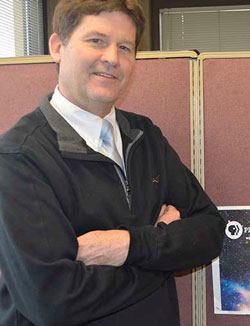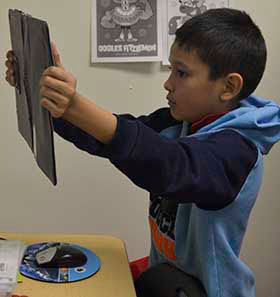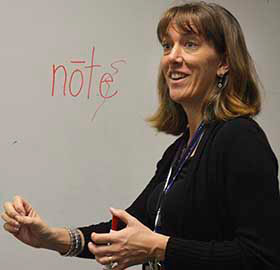Four students gazed at their iPads to see lots of animals eating: squirrel, giraffe, camel, panda. Video over, teacher Heather Gauck asked them what they found interesting about how the animals ate.
“The panda’s a little bit like us,” offered third-grader Skylar Taylor. “When he eats he’s sitting up.”
“The giraffes eat leaves with their long necks,” chipped in Austin Kern.
In this pull-out study group at Harrison Park School, Gauck was calling on a handy resource to help students learn the eating habits of nature’s creatures. It’s called PBS LearningMedia – an online tool available to all teachers in Kent County and beyond, but unknown to many.

That’s too bad, says Gauck, who works with Harrison Park students to aid their learning with technology. She’s found PBS LearningMedia to be of great help, with its 120,000 digital resources including videos, lesson plans and interactive materials.
What’s more, it’s available for free.A more advanced version used by Gauck costs a modest $1,000 per year for schools.
Either way it’s a great deal, Gauck says. She notes the service provides a wide variety of teaching materials that are grade-appropriate, aligned to Common Core standards — and are “safe” for children.
“I know that if I’m using this or if the kids are getting on it, that you’re not going to run into anything inappropriate,” such as adult ad content, Gauck says, adding it has something for all learning levels. “I love how you can search pre-K all the way up to teacher professional development. There’s so much out there.”

Students Can Create Content
For Gauck, a special-education teacher and a national proponent of technology in the classroom, PBS LearningMedia is a valuable tool in helping students succeed – especially those stymied by traditional book-learning.
LearningMedia is an instructional resource provided locally by Grand Valley State University and WGVU Public Media, its public-broadcasting arm. While all teachers can use the free service, the fee-based Custom Service provides additional features such as alignment to state standards, more data analytics and more videos, including all of the Ken Burns documentaries.
The Custom Service is used by 19 area schools, 10 of which were funded by a three-year pilot grant from the Robert E. & Marcia L. Schaub Family Foundation when the service was launched in 2013. They include schools in Lowell, Forest Hills, Godfrey-Lee, Grand Rapids, Grandville and Kenowa Hills.
More than 4,300 area teachers are registered to use the Custom Service, and total LearningMedia page views have grown each year to an average of more than 24,000 per month so far in 2017.
Many teachers were trained to use the site by Mike Fillman, a former teacher himself at Lowell Area Schools. Now the education coordinator for WGVU Public Media, he provides workshops to classroom teachers as well as to GVSU student teachers.
Fillman first saw the advantages of PBS LearningMedia while teaching at Murray Lake Elementary. The site allowed students to go into more depth with their studies and to tackle projects that led them to new discoveries, he says. For instance, through a feature called Storyboard, students can research a topic then upload videos or pictures to create a presentation.
“One time I said, ‘What do you want to know more about?’” Fillman recalls of an open-ended research assignment. “The 25 kids had 25 questions answered that they didn’t really even think about” before the project.

Lessons Align with Standards
Students have also used the Storyboard feature to tackle historical or news topics, such as the JFK assassination and Chinese New Year, the latter by a Chinese student from Grandville. That gives them real-world perspective on topics that interest them, while helping teachers to “get to that deeper level of knowledge,” Fillman says.
Teachers can draw on more than 120 lesson plans, listed with corresponding academic standards and many created by teachers themselves. An interactive lesson on projectile motion from the University of Colorado, for instance, invites students to explore mass and air resistance by shooting a cannon from various angles. Other lessons were created by WGVU, such as one about Great Lakes shipping focused on Saugatuck.
One morning earlier this spring, Heather Gauck used PBS LearningMedia to help students learn how the silent “e” affects word pronunciation.
Students scanned a printed-out QR code that took them to one of more than 1,000 online exercises about silent letters, including a clip from “The Electric Company.” She combined the online component by writing words on the board, and students colored in a puzzle of words with long and short vowel sounds.

For many students, the combination of digital resources with traditional paper-and-pencil can make a dramatic difference, says Gauck, who has helped train teachers in PBS LearningMedia and who organized Innovation Classroom, a high-tech resource site for teachers.
“It has given a voice to my kids who are usually voiceless,” such as those who struggle with book-reading, she said. “It’s night and day.”
CONNECT
iPads Help Individualize Lessons, Lead to ‘Higher Level Thinking’











